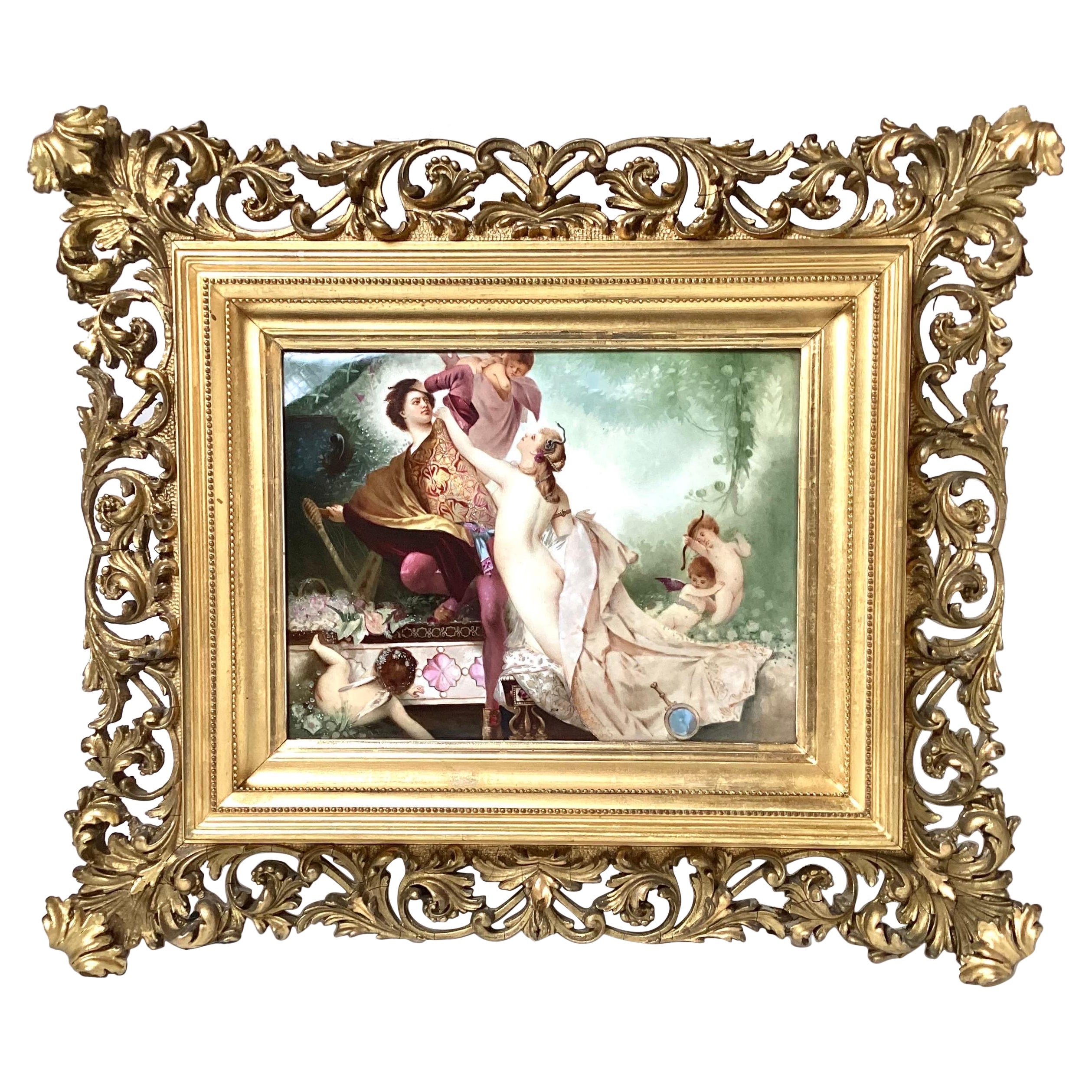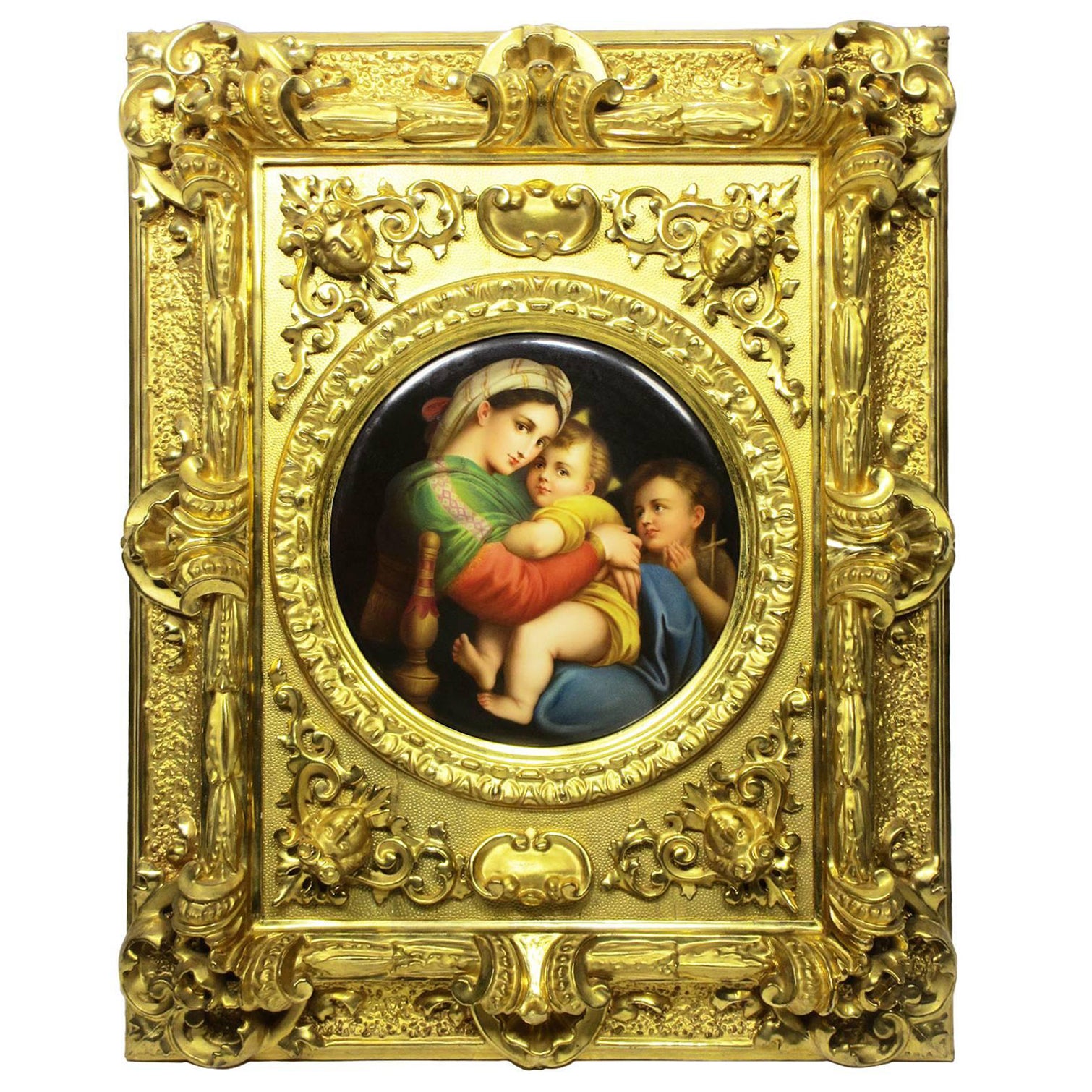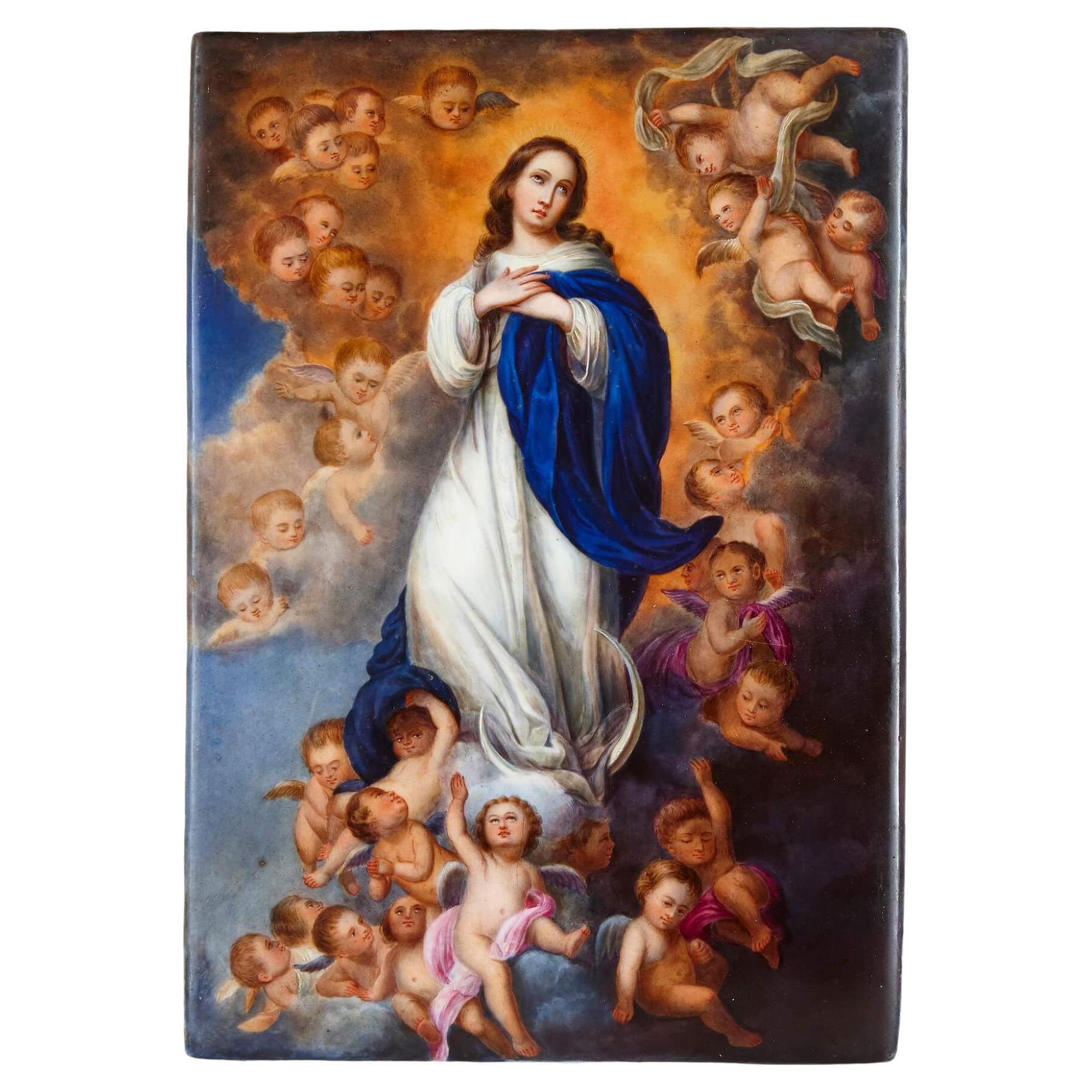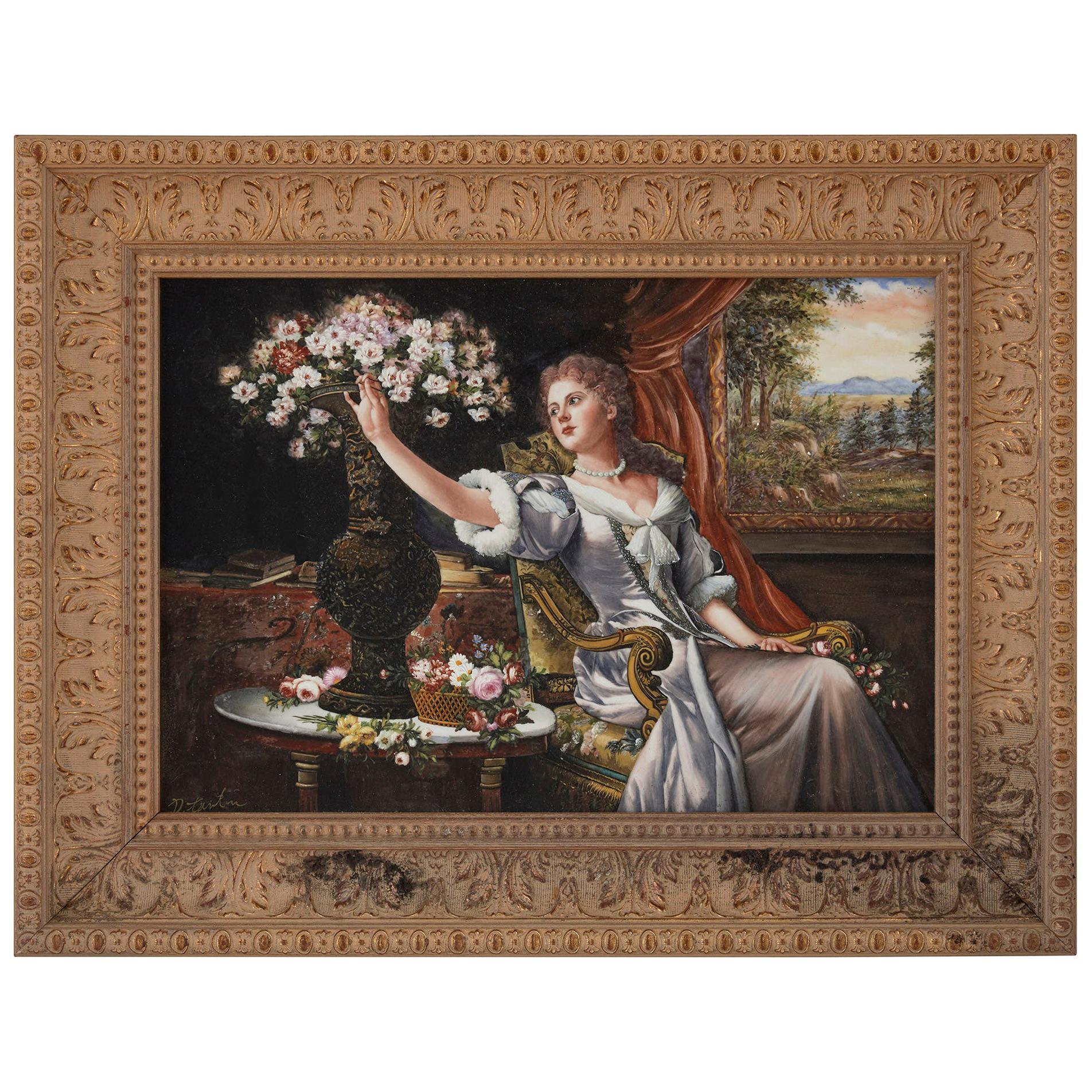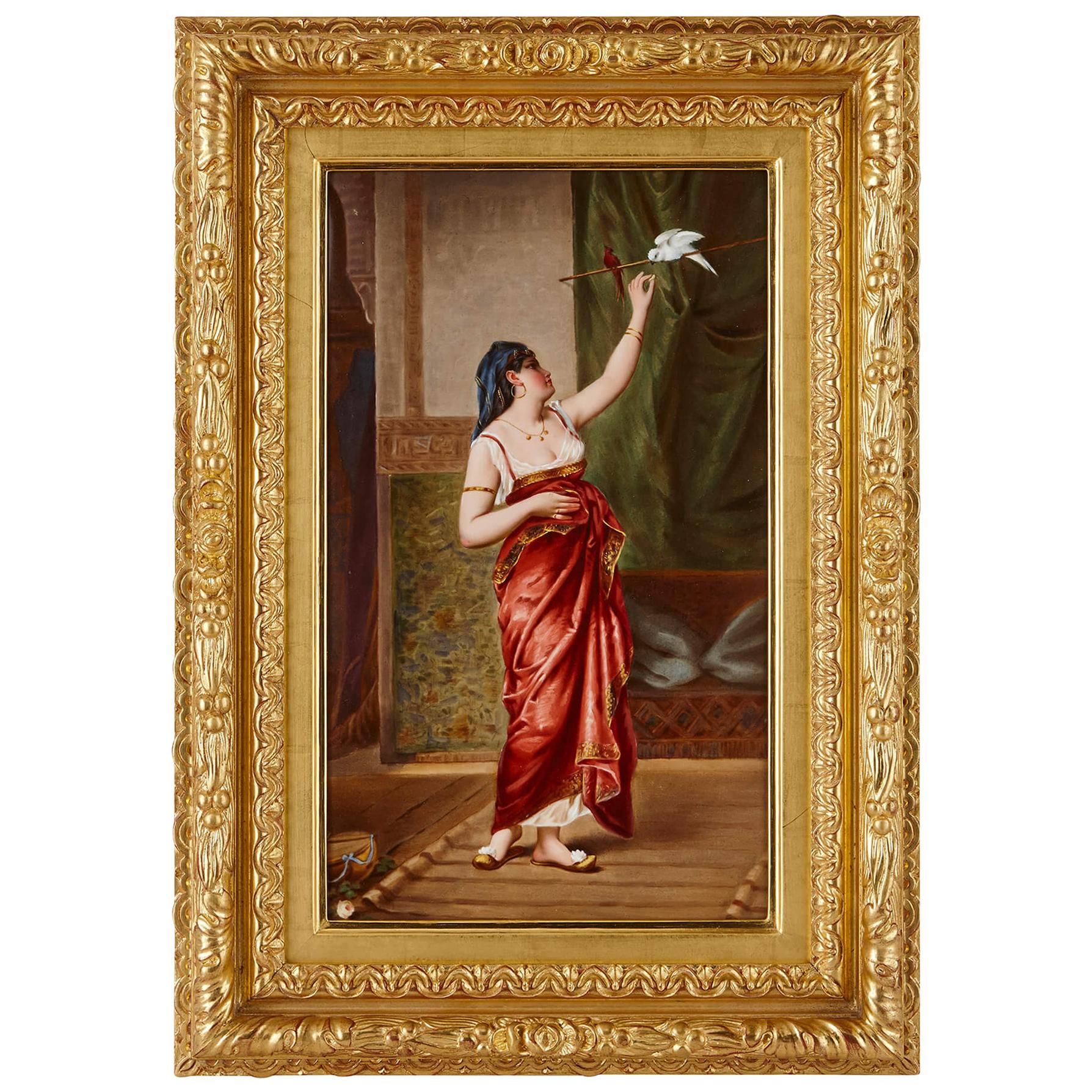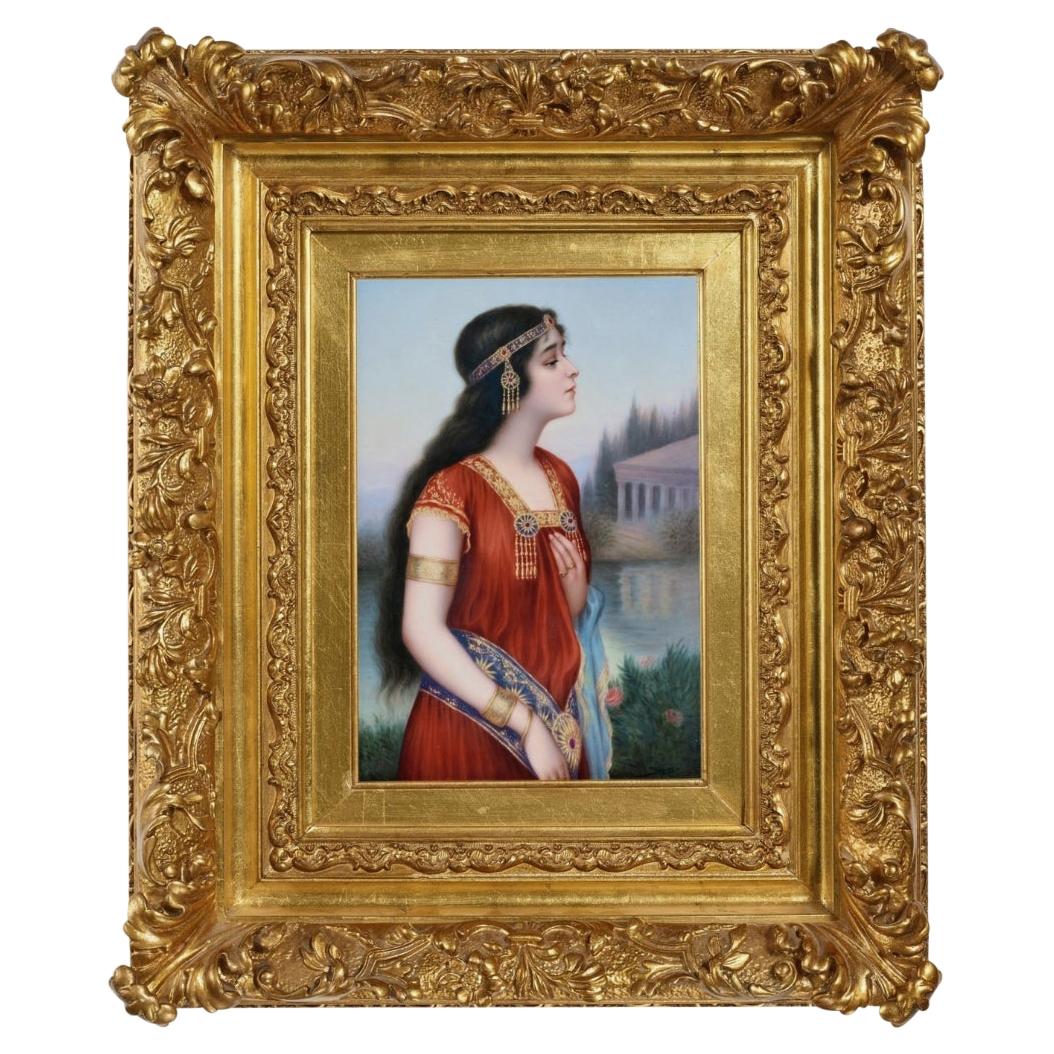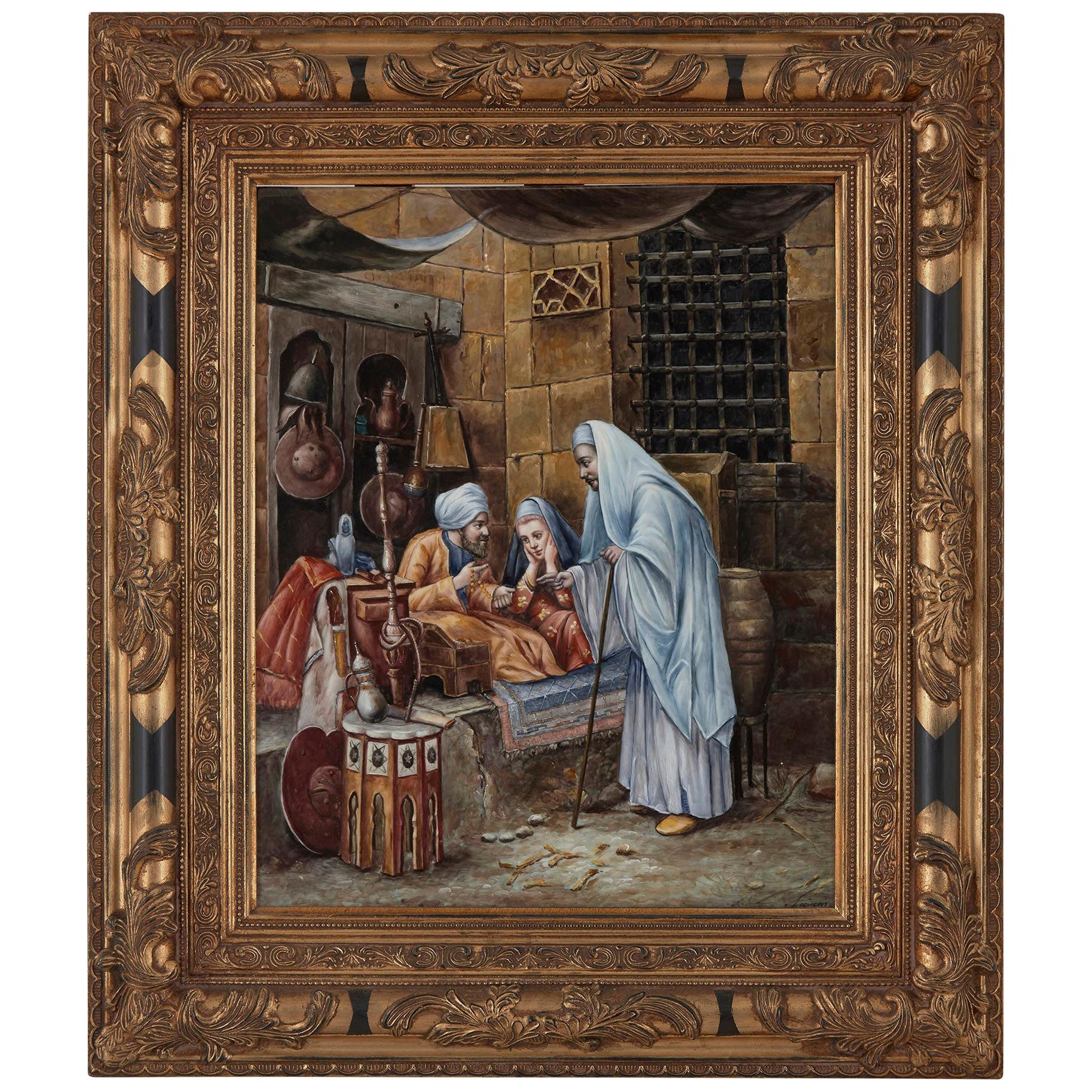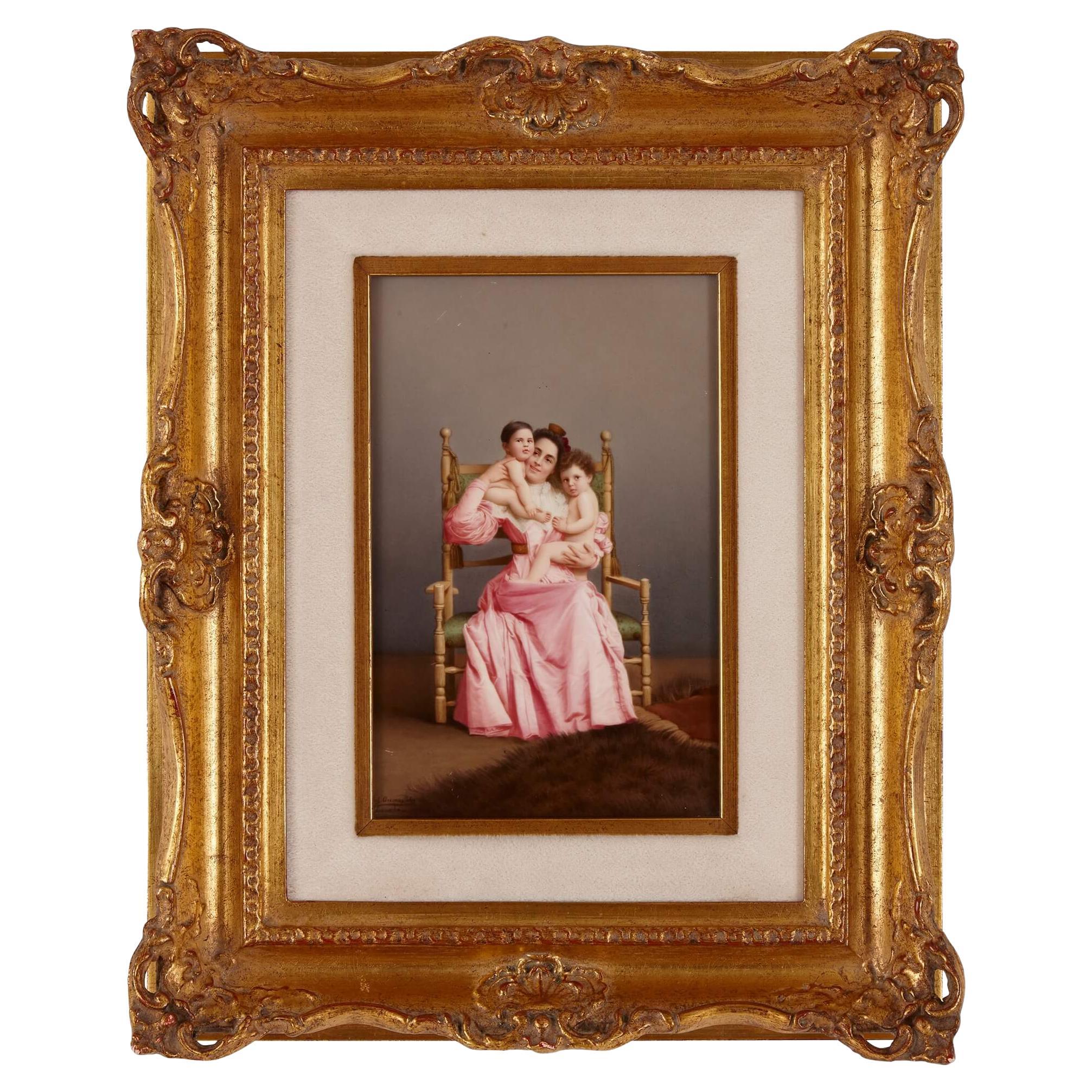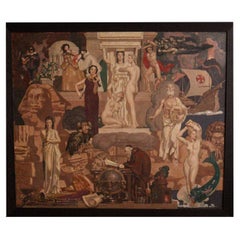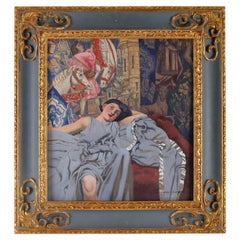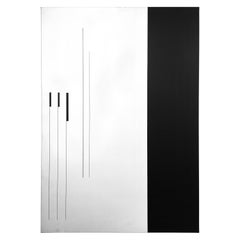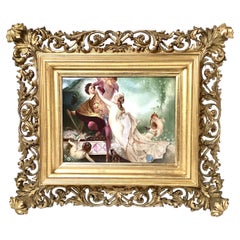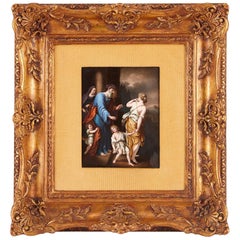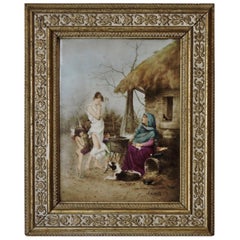
E.Merville Painting on Porcelain La Cigale et La Fourmi
View Similar Items
Want more images or videos?
Request additional images or videos from the seller
1 of 7
E.Merville Painting on Porcelain La Cigale et La Fourmi
About the Item
- Dimensions:Height: 11.82 in (30 cm)Width: 8.67 in (22 cm)Depth: 1.19 in (3 cm)
- Style:Napoleon III (Of the Period)
- Materials and Techniques:
- Place of Origin:
- Period:
- Date of Manufacture:circa 1890
- Condition:
- Seller Location:Saint-Ouen, FR
- Reference Number:1stDibs: LU2612310814053
About the Seller
4.9
Vetted Seller
These experienced sellers undergo a comprehensive evaluation by our team of in-house experts.
1stDibs seller since 2017
57 sales on 1stDibs
Typical response time: 1 hour
More From This SellerView All
- "Ce qu'évoquent les Livres" by Émile Aubry '1880-1964'By Louis AubryLocated in Saint-Ouen, FR"Ce qu'évoquent les Livres" Allegory of the Literature Oil on canvas Signed on the lower part beside parchment 111 x 133 x 2 cm Framed 125 x 146 x 7 cm Provenance: Collection Georges AUBRY, brother of the artist Bibliography: Illustrated in catalogue «Regards de peintre» , Suzanne AUBRY-CASANOVA, 1997, p.104 After trying years of forced confinement due to the war, he composed this allegorical fresco on the theme of Literature, Science and Arts was painted by Émile Aubry for his younger brother Georges Aubry, who had intended it for his library. This work, composed on the theme of the book it symbolizes, in its diversity by allegorical characters, he cannot help ordering the painting around Art, which he places at the top of the scale of human...Category
Vintage 1940s French Art Deco Paintings
MaterialsCanvas
- Raphaël DELORME (1885-1962) « Jeune femme dans son intérieur »By Raphael DelormeLocated in Saint-Ouen, FRRaphaël DELORME (1885-1962) « Jeune femme dans son intérieur » Oil on panel Signed Lower right Framed 36 x 32 cm Total 50 x 47 cm Raphaël Delorme was a French painter born in 1885 ...Category
Vintage 1920s French Art Deco Paintings
MaterialsWood, Paint
- Pierre Legendre, Accord II, circa 1980By Pierre LegendreLocated in Saint-Ouen, FRPierre Legendre (1932-2009) Accord II oil on canvas circa 1980 Measures: 116 x 81 cm. Pierre Legendre, born in 1932 in Haute-Marne, moved to Paris at the age of 22. After classes at the Estienne school in Paris as well as those of the Beaux-Arts, he worked for several big houses and was the originator of logos for big brands like Hermès or Nina Ricci. He entered the academy of the painter Henri GOETZ, which allowed him to familiarize himself with abstract, geometric art. He exhibited from the 1970s, as in 1979 at UNESCO in Paris. A discreet painter, he nevertheless participated in the 80s and 90s in many artists' salons (Comparaison, Grand et Jeunes d'Aujourd'hui, Réalités Nouvelles). Pierre Legendre is of deep integrity, of great moral rigor, his geometric and abstract art also reflects a quest for spirituality and philosophical reflection. Although denying itself to belong to Concrete Art, Legendre by its taste for purism and the immateriality of the straight line is not so far removed from, among others, the art of Jean Gorin...Category
Vintage 1980s French Modern Paintings
MaterialsPaint
$7,350 Sale Price25% Off - French 19th Century Pair of Porcelain Cache-PotsLocated in Saint-Ouen, FRPair of polychromed hand painted porcelain with Japonisme floral decoration Ormolu-mounted with open-worked base and rim Louis XVI Style circa 1880.Category
Antique 1870s French Chinoiserie Planters, Cachepots and Jardinières
MaterialsOrmolu
$1,933 Sale Price / set20% Off - Pair of French Napoléon III Curule ArmchairsLocated in Saint-Ouen, FRPair of French Napoléon III Curule Armchairs Moulded, carved, blackened wood, enhanced with gold. Open-banded back decorated with interlacing, X-bas...Category
Antique 1890s French Napoleon III Armchairs
MaterialsWood, Trimming
- Pair of Porcelain Vases Ormolu-Mounted in Lamps by Gagneau Paris XIXth CenturyBy Gagneau ParisLocated in Saint-Ouen, FRPair of large Japanese Porcelain Cone Shape Vases with Imari decoration Important mounts in ormolu and gilded metal, the base decorated with a laurel wreath, the upper part of falling leaves and a frieze of knotted ribbon. The mounts signed Gagneau, 115 R. Lafayette. Circa 1860 With their original aluminium bulb cover and original gilding Vase it self Height 47 cm The Gagneau Company is one of the most famous lighting factories in Paris in the nine-teenth century, established in 1800 at 25 rue d'Enghien in Paris and later at 115 rue de Lafayette. She has participated in many exhibitions throughout this century. She began in 1819 with the Exposition des Produits de l'Industrie and later participated in the Universal Exhibitions where she was part of the jury in the category of art bronzes (class 25) at the Universal Exhibition in Paris in 1889. "Imari" was simply the trans-shipment port for Arita wares, from where they went to the for-eign trading outposts at Nagasaki. It was the kilns at Arita which formed the heart of the Japanese porcelain industry. Arita's kilns were set up in the 17th century, after kaolin was discovered in 1616. A popular legend attributes the discovery to an immigrant Korean potter, Yi Sam-Pyeong (1579–1655), although most historians consider this doubtful. After the discovery, some kilns began to produce revised Korean-style blue and white porcelains, known as Early Imari, or "Shoki-Imari". In the mid-17th century, there were also many Chinese refugees in northern Kyushu due to the turmoil in China, and it is said that one of them brought the overglaze enamel coloring technique to Arita. Thus Shoki-Imari developed into Ko-Kutani, Imari, and later Kakiemon, which are sometimes taken as a wider group of Imari wares. Ko-Kutani was produced around 1650 for both export and domestic market.Kutani Ware is characterized by vivid green, blue, purple, yellow and red colors in bold designs of landscapes and nature. Blue and white porcelain pieces continued to be produced and they are called Ai-Kutani. Ko-Kutani Imari for the export market usually adopted Chinese design structure such as kraak style, whereas Ai-Kutani for the domestic market were highly unique in design and are ac-cordingly valued very much among collectors. Ko-Kutani style evolved into Kakiemon-style Imari, which was produced for about 50 years around 1700. Kakiemon was characterized by crisp lines, and bright blue, red and green designs of dramatically stylized floral and bird scenes. Imari achieved its technical and aes-thetic peak in the Kakiemon style, and it dominated the European market. Blue and white Kakiemon is called Ai-Kakiemon. The Kakiemon style transformed into Kinrande in the 18th century, using underglaze blue and overglaze red and gold enamels, and later additional colors. Imari began to be exported to Europe when the Chinese kilns at Jingdezhen were damaged in the political chaos and the new Qing dynasty government halted trade in 1656–1684. Ex-ports to Europe were made through the Dutch East India Company, and in Europe the des-ignation "Imari porcelain" connotes Arita wares of mostly Kinrande Imari. Export of Imari to Europe stopped in mid-18th century when China resumed export to Europe, since Imari was not able to compete against Chinese products due to high labor costs. By that time, however, both Imari and Kakiemon styles were already so popular among Eu-ropeans that the Chinese export porcelain copied both, a type known as Chinese Imari. At the same time, European kilns, such as Meissen and English potteries such as Johnson Bros. and (Royal) Crown Derby, also imitated the Imari and Kakiemon styles. Export of Imari surged again in late 19th century (Meiji era) when Japonism flourished in Europe.Thus, in the western world today, two kinds of true Japanese Imari can...Category
Antique 1880s French Japonisme Table Lamps
MaterialsBronze
You May Also Like
- 19th Century Painting on Porcelain in Gilt FrameLocated in Lambertville, NJA painting on porcelain of a nobleman and nude woman with cupids, elaborately painted and highly detailed. The original gilt wood frame with reti...Category
Antique 1880s Austrian Paintings
MaterialsPorcelain, Giltwood
- Fine 19th Century Porcelain Plaque of La Madonna della Sedia after Raphel SanzioBy Raphael (Raffaello Sanzio da Urbino)Located in Los Angeles, CAA very fine German 19th century circular porcelain plaque painting of La Madonna della Sedia after Raphael Sanzio (1483-1520), depicting a seated Madonna and child next to a child Saint John the Baptist, within a giltwood carved figural frame, the plaque inscribed "Raphael" on the reverse and bearing a label that reads "Julius Greiner...Category
Antique 19th Century German Renaissance Paintings
MaterialsPorcelain, Wood
$9,450 Sale Price24% Off - 19th Century KPM Porcelain Plaque, After Old Master PaintingBy Adriaen van der WerffLocated in London, GBThis fine KPM porcelain plaque depicts the biblical story of the expulsion of Hagar by Abraham. Abraham is shown bearded in a blue robe, as he casts away his mistress Hagar and her s...Category
Antique 19th Century German Paintings
MaterialsGiltwood, Porcelain
- Pair of Hand-Painted Porcelain Plaques of Floral Still-Life PaintingsBy KPM PorcelainLocated in New York, NYA fine pair of hand-painted porcelain plaques of floral still-life paintings with original giltwood frames. These beautiful floral still-life paintings have been hand-painted on porc...Category
Antique 1870s German Louis XVI Paintings
MaterialsPorcelain, Giltwood
$7,720 Sale Price / set20% Off - Antique porcelain plaque after MurilloBy Bartolomé Esteban MurilloLocated in London, GBAntique porcelain plaque after Murillo Continental, 19th Century Height 28cm, width 19.5cm, depth 1cm This finely painted antique porcelain plaque depic...Category
Antique 19th Century European Baroque Paintings
MaterialsPorcelain
- Large Renaissance Style Painted Porcelain PlaqueBy KPM PorcelainLocated in London, GBLarge Renaissance style painted porcelain plaque German, 20th century Frame: Height 50cm, width 64cm, depth 6cm Plaque: Height 34cm, width 49cm, depth 0.5cm In this beautifully painted porcelain plaque, a young woman in fine aristocratic clothing sits in a dark Renaissance style interior scene. She sits in a gold armchair, covered in ornate floral upholstery, stretching out her arm to pluck a rose from a bouquet of flowers on the table beside her. Behind her is a landscape painting with red velvet...Category
20th Century German Renaissance Porcelain
MaterialsPorcelain, Giltwood
Recently Viewed
View AllMore Ways To Browse
Giltwood Frame Oil 19th Century
Gold Wall Panels
Wall 3d Painting
Neoclassicism Painting
Pair Of Framed Panels
Pair Of Antique Oil Paintings Paintings
Antique Oil Painting Italy
Oil Pairings 19th Century
Wall Painting Set Two
Antique Religious Painting Paintings
Antique Religious Paintings
Antique Religious Painting
Vintage Los Angeles Wall Art
1930 Art Deco Painting
Large Midcentury Modern Painting
Vintage Collage Wall
French Hand Painted Panels
Antique Stone Wall
